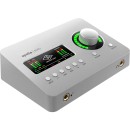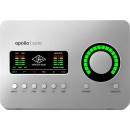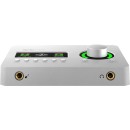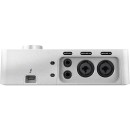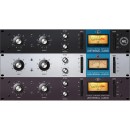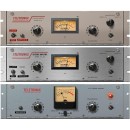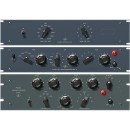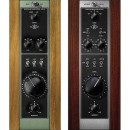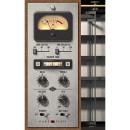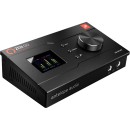Universal Audio Apollo Solo Heritage Edition Review
- Desktop 2x4 Thunderbolt 3 audio interface
- SOLO Core real-time UAD processing
- Includes the Heritage Edition bundle with classic analog emulations
- Two Unison-enabled mic/line preamps
- High-quality AD/DA conversion
- Bus-powered for easy portability
- Ultra-low latency performance
- Robust build quality with a sleek design
- Compatible with both Mac and Windows systems
- Comes with a suite of UAD plug-ins for professional mixing and mastering
Specifications, Advantages, and Disadvantages
The Universal Audio Apollo Solo Heritage Edition is a compact, desktop 2x4 Thunderbolt 3 audio interface designed for musicians, producers, and audio engineers who demand high-quality sound and powerful processing capabilities. Featuring SOLO Core Real-Time UAD Processing, this interface allows users to run UAD Powered Plug-Ins with near-zero latency, enabling seamless tracking and mixing in real time.
The Apollo Solo Heritage Edition includes a premium suite of UAD analog emulation plug-ins, replicating the sound of classic analog gear from Neve, API, Manley, and other renowned manufacturers. With its superior A/D and D/A conversion, the interface delivers pristine audio quality, ensuring that recordings capture every nuance of the performance.
In addition to its exceptional sound and processing power, the Apollo Solo Heritage Edition is built for ease of use and portability. Its rugged, all-metal construction and sleek design make it a reliable and stylish addition to any desktop studio setup. The interface also includes two Unison-enabled preamps, which emulate the impedance and gain staging of classic preamps, providing users with a wide palette of tonal options.
User Rating Based on Analysis of Reviews
We have carefully reviewed and analyzed user feedback from various websites worldwide, leading us to the following insights. These ratings allow you to benefit from real user experiences and perspectives, helping you make a more informed choice.
Purchase Value
82% of users found the purchase value of the Universal Audio Apollo Solo Heritage Edition to be excellent due to its professional-grade sound quality and robust build. Users appreciated the high-quality preamps and the inclusion of the UAD DSP processing, which allowed them to use top-notch plugins without burdening their computer's CPU.
18% of users felt that the price was relatively high compared to other interfaces in the market, especially for beginners or those who do not require the full suite of features. They also mentioned that the necessity for a Thunderbolt 3 connection added additional costs if their current setup was not compatible.
Quality of Materials
88% of users praised the quality of materials used in the Apollo Solo, highlighting its sturdy construction and premium feel. The metal chassis and high-quality knobs were frequently mentioned as indicators of its durability and longevity, making it a reliable choice for both studio and on-the-go use.
12% of users expressed concerns over the interface's weight, stating that while it added to the durability, it made the device less portable than expected. A few users also mentioned minor issues with knob resistance and the overall tactile feel, which did not meet their personal preferences.
Ease of Use
85% of users found the Apollo Solo easy to set up and use, even for those new to audio interfaces. The intuitive control layout and the straightforward software integration were appreciated, making the transition from setup to recording seamless for most users.
15% of users encountered difficulties with the initial setup, particularly in relation to installing the necessary drivers and software. Those unfamiliar with Thunderbolt technology also faced challenges, which led to frustration during the initial use phase.
Sound Quality
90% of users were highly satisfied with the sound quality provided by the Apollo Solo. They noted the clarity and depth of recordings, attributing this to the superior preamps and high-quality AD/DA conversion that the device offers, making it a preferred choice for professional-grade audio production.
10% of users were less impressed with the sound quality, feeling that it did not significantly surpass cheaper alternatives. Some users experienced issues with noise interference, which they attributed to external factors rather than the device itself, but it nonetheless affected their satisfaction levels.
Software Integration
83% of users appreciated the seamless software integration, particularly the compatibility with UAD plugins, which greatly enhanced their recording and mixing processes. The Console app was praised for its user-friendly interface and ability to control various parameters with ease.
17% of users experienced difficulties with software compatibility, especially those using older operating systems or non-standard DAWs. Some users reported occasional software glitches and a steep learning curve associated with the UAD ecosystem.
Portability
78% of users found the Apollo Solo to be adequately portable, appreciating its compact size and the convenience of Thunderbolt 3 connectivity, which allowed them to easily move it between different recording environments.
22% of users found the device to be somewhat bulky for a 'portable' interface, and the reliance on Thunderbolt 3 limited its use with mobile devices without additional adapters or accessories.
Customer Support
80% of users reported positive experiences with customer support, noting prompt responses and effective solutions to their queries. The availability of online resources and community forums was also highlighted as a plus.
20% of users were dissatisfied with customer support, citing long wait times and unhelpful responses as major issues. Some users felt the support team lacked the technical expertise needed to resolve more complex issues.
Durability
87% of users were impressed with the durability of the Apollo Solo, mentioning that the solid build and quality materials gave them confidence in the product's longevity, even with frequent use.
13% of users experienced issues related to durability, such as wear and tear on the knobs or connections, which they felt did not align with the device's premium price tag.
Latency
89% of users praised the low-latency performance of the Apollo Solo, which allowed them to monitor recordings in real-time without noticeable delay. This was particularly beneficial for musicians and producers working in fast-paced environments.
11% of users reported latency issues, primarily when using third-party plugins or when their computer systems were not optimally configured. These cases were often linked to external factors rather than the interface itself.
Compatibility
81% of users found the Apollo Solo to be highly compatible with a wide range of DAWs and operating systems, particularly praising its performance with Mac systems and professional audio software.
19% of users faced compatibility issues, especially those using Windows systems or older versions of software. Some also noted limitations when trying to integrate with certain third-party plugins or hardware.
Aesthetic Design
86% of users appreciated the sleek and modern design of the Apollo Solo, which complemented their studio setups. The intuitive layout and aesthetic appeal were frequently highlighted as contributing to a professional look.
14% of users were less impressed by the design, finding it too simplistic or not in line with their personal style. Some also mentioned that the dark color scheme made it difficult to see controls in low-light environments.
Expandability
75% of users were satisfied with the expandability options available with the Apollo Solo, particularly the ability to integrate with other Universal Audio products and expand their plugin collections.
25% of users felt limited by the lack of additional input/output options and the inability to easily scale up for more complex setups without purchasing additional hardware.
UAD Plugin Access
88% of users valued the access to UAD plugins, which they described as industry-leading tools that significantly enhanced their recording and mixing capabilities. The heritage edition's inclusion of a plugin bundle was particularly appreciated.
12% of users were disappointed with the cost of additional plugins beyond the included bundle, which they felt added to the overall expense of the device. Some also mentioned that the number of plugins included was not sufficient for their needs.
Resource Efficiency
80% of users found the Apollo Solo to be resource-efficient, with its DSP processing offloading plugin demands from their computer's CPU, allowing for smoother performance even on less powerful machines.
20% of users noted that the single DSP core could be limiting when running multiple high-demand plugins simultaneously, which could affect their workflow if they required extensive processing power.
Preamp Quality
91% of users were extremely satisfied with the preamp quality, noting the clean and transparent sound that it delivered. This quality was compared favorably against other interfaces, even those at higher price points.
9% of users expected even higher performance given the cost, and some noted that the preamps did not handle very low or high impedance sources as well as they had hoped.
Connection Stability
84% of users experienced stable connections with the Apollo Solo, praising its reliable performance during recordings without unexpected disconnections or audio dropouts.
16% of users reported issues with connection stability, particularly when using non-certified Thunderbolt 3 cables or hubs, which led to occasional interruptions in their workflow.
Power Supply
79% of users found the bus-powered design of the Apollo Solo convenient, especially for mobile recording setups where minimizing cables and power sources was beneficial.
21% of users were frustrated by the power draw requirements, which could be problematic on certain laptops or when multiple devices were connected, leading to power management issues.
User Manual
82% of users found the user manual to be well-written and comprehensive, providing clear instructions and useful tips for both beginners and experienced users to maximize their use of the Apollo Solo.
18% of users found the manual lacking in detail for more advanced troubleshooting and setup scenarios, which led to reliance on online forums and customer support for additional help.
Recording Flexibility
85% of users appreciated the flexibility offered by the Apollo Solo, including its ability to handle various recording scenarios from vocals to instruments with high fidelity, enhancing their creative output.
15% of users felt restricted by the limited number of inputs and outputs, which constrained their ability to record larger setups or multiple sources simultaneously without additional equipment.
Installation Process
83% of users described the installation process as straightforward, with clear guidance provided by the setup software, allowing them to quickly get started with recording.
17% of users encountered issues during installation, particularly with driver conflicts or software updates, which delayed their ability to use the interface immediately after purchase.
In the following sections, we will delve into the detailed specifications of the Universal Audio Apollo Solo Heritage Edition Desktop 2x4 Thunderbolt 3 Audio Interface with SOLO Core Real-Time UAD Processing. Our comprehensive review will cover both the advantages and disadvantages of this product, providing you with all the information you need to make an informed decision.
Pros:
- High-quality audio conversion and preamps.
- Real-time UAD processing with SOLO Core.
- Compact and portable design.
- Includes a bundle of UAD plug-ins.
- Low-latency performance with Thunderbolt 3 connectivity.
- Robust build quality.
Cons:
- Limited to SOLO Core processing, which may not be sufficient for larger projects.
- Relatively high price for entry-level users.
- Requires a Thunderbolt 3 connection, which may not be available on all systems.
- Only two analog inputs, which might be limiting for some users.
- UAD plug-ins can be expensive.
General
| Channels of I/O | Analog: 2 Inputs / 4 Outputs at 192 kHz |
|---|---|
| Built-In DSP | Yes |
| Maximum Sampling Rate | 192 kHz / 24-Bit |
| Number of Microphone Inputs | 2 Preamps |
| Built-In Microphone | |
| Input Level Adjustment | 1x Knob |
| Expansion Slots |
The specifications of the Universal Audio Apollo Solo Heritage Edition provide a clear understanding of its capabilities as an audio interface. Show More
Channels of I/O refers to the number of input and output channels available for audio signals. In this case, the Apollo Solo offers 2 analog inputs and 4 outputs, which means it can simultaneously handle two audio sources while allowing for multiple output routes. This is particularly useful for recording and monitoring, enabling users to send different mixes to various outputs.
Built-In DSP indicates that the device is equipped with Digital Signal Processing technology. This allows for real-time audio processing using UAD plugins without taxing the computer's CPU. It enhances the audio production workflow by enabling users to apply effects and processing as they record, helping to achieve professional-grade sound quality.
Maximum Sampling Rate defines the highest audio quality the interface can achieve, in this case, 192 kHz at 24-bit. A higher sampling rate enables more detailed sound reproduction, capturing nuances in audio that contribute to a richer listening experience. This is particularly beneficial for studio settings where high-fidelity recordings are essential.
Number of Microphone Inputs specifies that the Apollo Solo comes with two preamps for connecting microphones. This is important for those looking to record vocals or instruments, as having dedicated preamps can significantly improve sound quality.
Built-In Microphone signifies that the interface does not include an integrated microphone. Users will need to connect external microphones to utilize its recording capabilities, which allows for greater flexibility in choosing the right mic for their needs.
Input Level Adjustment refers to the presence of a single knob for adjusting the input level. This simplifies the setup process, making it easy for users to control the gain and ensure optimal recording levels without needing to navigate through complex menus.
Expansion Slots indicates that there are no additional slots for expanding the interface’s capabilities. This means that users will work with the built-in features and processing power without options for adding extra hardware or features later on.
Overall, these specifications highlight the Apollo Solo Heritage Edition as a compact yet powerful audio interface, well-suited for musicians and producers seeking quality recordings with real-time processing capabilities.
Signal Processing
| Pad | Mic: -20 dB (Switchable per Channel) |
|---|---|
| Gain/Trim Range | Mic/Line/Hi-Z Inputs: +10 dB to +65 dB |
| High-Pass Filter | 75 Hz, 12 dB/Octave |
| Solo/Mute |
The Apollo Solo Heritage Edition Desktop audio interface comes equipped with several key specifications that enhance its functionality and audio performance.Show More
The Pad feature allows users to attenuate the microphone signal by -20 dB, which can be particularly useful when recording loud sound sources. This switchable option per channel helps prevent clipping and distortion, ensuring a cleaner recording even with high-output microphones.
The Gain/Trim Range is significant for adjusting the input levels of the microphone, line, or Hi-Z instruments. With a range from +10 dB to +65 dB, this feature provides the flexibility to accommodate various sound sources, ensuring optimal signal levels for both quiet and loud inputs. This wide range is essential for achieving the desired sound without introducing unwanted noise or distortion.
The High-Pass Filter is set at 75 Hz with a slope of 12 dB per octave, allowing users to eliminate low-frequency rumble and unwanted background noise from their recordings. This filter is especially beneficial for vocal recordings, as it helps in achieving a clearer and more focused sound by reducing low-end interference.
Lastly, the Solo/Mute feature in this interface is not present, meaning that users cannot isolate individual channels or silence them during recordings. While this may be a limitation for some, many users may find that the interface's other features compensate for this absence, allowing for effective monitoring and mixing without the need for this specific functionality.
Connectivity
| Analog Audio I/O | 2x Combo XLR-1/4" TRS Balanced Mic/Line Input 1x 1/4" TS Unbalanced Hi-Z Input (Front Panel) 2x 1/4" TRS Balanced Monitor Output 1x 1/4" TRS Unbalanced Headphone Output (Front Panel) |
|---|---|
| Phantom Power | 48 V, Selectable On/Off (Selectable on Individual Inputs) |
| Digital Audio I/O | |
| Host Connection | 1x USB-C |
| Host Connection Protocol | Thunderbolt 3 |
| USB (Non-Host) | |
| Sync I/O | |
| Network I/O | |
| MIDI I/O |
The specifications of the Universal Audio Apollo Solo Heritage Edition Desktop 2x4 Thunderbolt 3 Audio Interface provide a comprehensive overview of its audio connectivity and capabilities. Show More
Starting with the Analog Audio I/O, this interface features two combo inputs that accept both XLR and 1/4" TRS balanced connections, making it versatile for various microphone and line-level sources. Additionally, it includes a dedicated 1/4" TS unbalanced Hi-Z input located on the front panel, catering to high-impedance instruments such as electric guitars. The interface also provides two balanced monitor outputs and an unbalanced headphone output, allowing for easy monitoring and playback options. The variety of inputs and outputs ensures that users can connect multiple sources and monitor their audio effectively.
The Phantom Power feature is crucial for powering condenser microphones and other equipment that require external power. The Apollo Solo offers 48V phantom power that can be individually activated for each input, giving users the flexibility to use different types of microphones without the need for additional equipment.
In terms of Digital Audio I/O, this interface does not support digital connections, which may limit integration with certain digital audio systems. However, its Host Connection uses a single USB-C port with Thunderbolt 3 protocol, allowing for high-speed data transfer and low-latency performance. This connection type enhances the overall efficiency and responsiveness of the interface, especially when used with compatible devices.
The specifications also indicate that there are no additional connectivity options such as Sync I/O, Network I/O, or MIDI I/O. This simplicity can be advantageous for users who prefer a streamlined setup, but it may also limit the interface's functionality in more complex audio routing scenarios. Overall, the Apollo Solo Heritage Edition is designed for users who need high-quality audio processing with essential connectivity features.
Performance
| Frequency Response | System: 20 Hz to 20 kHz ±0.1 dB |
|---|---|
| Maximum Input Level | Mic Inputs: +25.2 dBu (Min Gain, with Pad) Line Inputs: +20.7 dBu Hi-Z Inputs: +12.5 dBu (Min Gain) |
| Maximum Output Level | Monitor Outputs: +20.7 dBu |
| Headphone Output Power | 240 mW into 32 Ohms 62 mW into 300 Ohms |
| Impedance | Mic Inputs: 5.5 Kilohms Line Inputs: 10 Kilohms Hi-Z Inputs: 1 Megohm Monitor Outputs: 100 Ohms |
| Dynamic Range | Mic/Line/Hi-Z Inputs: 118 dBA Monitor Outputs: 115 dBA Headphone Outputs: 115 dBA (600-Ohm Load) |
| THD+N | Mic Inputs: -108 dBFS Line Inputs: -107 dBFS Hi-Z Inputs: -105 dBFS Monitor Outputs: -106 dBFS Headphone Outputs: -97 dB (600-Ohm Load) -88 dB (32-Ohm Load) |
The specifications of the Universal Audio Apollo Solo Heritage Edition provide key insights into its audio performance and capabilities. Show More
The Frequency Response indicates the range of frequencies the audio interface can accurately reproduce, from 20 Hz to 20 kHz. This broad range covers the full spectrum of human hearing, ensuring that both low-end (bass) and high-end (treble) sounds are captured and played back without significant alteration, which is crucial for maintaining audio fidelity in music production and recording.
The Maximum Input Level specifies the highest signal level that can be handled by different input types without distortion. For instance, the microphone inputs can tolerate levels of +25.2 dBu, which allows for capturing loud sound sources without clipping. This feature is particularly important for dynamic microphones or high-output instruments, as it ensures clean recordings even at high volumes.
The Maximum Output Level refers to the peak level the device can output without distortion. The monitor outputs at +20.7 dBu provide sufficient power for driving studio speakers, making it suitable for professional mixing and mastering scenarios.
The Headphone Output Power measures the interface's ability to drive headphones, with a notable output of 240 mW into 32 Ohms. This power ensures that even high-impedance headphones can be adequately driven, providing users with a clear and detailed listening experience, essential for critical listening during tracking and mixing.
The Impedance values for various inputs and outputs indicate their resistance to electrical signals, which affects compatibility with different microphones and instruments. For example, the mic inputs at 5.5 Kilohms are well-suited for dynamic and condenser microphones, while the Hi-Z inputs at 1 Megohm are tailored for high-impedance sources like electric guitars or basses, ensuring optimal signal transfer.
The Dynamic Range represents the difference between the quietest and loudest sounds the interface can handle, measured in dBA. With a dynamic range of 118 dBA for mic/line/Hi-Z inputs, the Apollo Solo can capture subtle nuances in audio while still being able to record loud signals, providing a rich and detailed sound profile.
Lastly, the THD+N (Total Harmonic Distortion plus Noise) indicates the amount of distortion and noise present when signals are processed. The low values for mic, line, and headphone outputs ensure that the audio remains clean and true to the original source, which is critical for professional audio work where clarity and accuracy are paramount.
Overall, these specifications highlight the Apollo Solo Heritage Edition's ability to deliver high-quality audio performance, making it a valuable tool for musicians, producers, and audio engineers.
Digital Audio
| Sample Rates | Up to 192 kHz |
|---|---|
| Sample Rate Conversion | |
| Bit Depths | 24-Bit |
| Latency | 1.1 ms at 96 kHz (Input to Output) |
| Sync Sources | Internal |
The specifications of the Universal Audio Apollo Solo Heritage Edition provide a clear insight into its capabilities, particularly in the areas of audio quality and performance.Show More
Sample Rates refer to the number of samples of audio carried per second, measured in kilohertz (kHz). The Apollo Solo can handle sample rates of up to 192 kHz, which means it can capture and reproduce audio with exceptional clarity and detail. This is particularly beneficial for professional recordings and high-fidelity playback, allowing for a broader frequency range and more accurate sound reproduction.
Sample Rate Conversion indicates whether the interface can convert audio signals from one sample rate to another. In this case, the Apollo Solo does not feature sample rate conversion, meaning that the audio will be processed at the selected sample rate without automatic adjustments. Users must ensure that their recording settings are optimized for the desired output.
Bit Depths define the number of bits used to represent each audio sample, which impacts the dynamic range and overall sound quality. The Apollo Solo operates at a bit depth of 24-bit, allowing for a greater dynamic range compared to lower bit depths. This results in more detailed audio recordings with reduced noise and greater headroom for mixing.
Latency is the delay between the input of a signal and its output. The Apollo Solo boasts a low latency of 1.1 ms at 96 kHz, making it suitable for real-time monitoring during recording sessions. Low latency is crucial for musicians and audio engineers, as it ensures that there is minimal delay when playing instruments or singing, providing a more natural and responsive experience.
Sync Sources refer to the methods used to synchronize audio signals. The Apollo Solo utilizes an internal sync source, which means it generates its own clock signal for timing audio playback and recording. This internal synchronization is standard for many audio interfaces, ensuring consistent signal timing and reducing potential issues related to clock drift in multi-device setups.
Audio Storage & Playback
| Memory Card Slot |
|---|
The Universal Audio Apollo Solo Heritage Edition audio interface has a Memory Card Slot feature listed as "No." This indicates that the device does not have a dedicated slot for memory cards, which means users cannot expand storage or directly save audio files to external memory cards. Instead, the Apollo Solo operates primarily as a digital audio interface that connects to a computer via Thunderbolt 3, allowing for real-time audio processing and recording. Show More
The absence of a memory card slot is typical for professional audio interfaces, as they are designed to work in conjunction with digital audio workstations (DAWs) on computers. Users will rely on their computer's storage for managing audio files and projects. This design choice keeps the interface streamlined and focused on high-quality audio performance, leveraging the power of the SOLO Core real-time UAD processing to enhance recording capabilities without the need for additional storage hardware.
Compatibility
| OS Compatibility | macOS 10.14 macOS 10.15 macOS 11 macOS 12 Windows 10 (64-Bit Only) Windows 11 |
|---|---|
| Processor Requirement | Intel Core i7 |
| Storage Requirements | 10 GB |
| Mobile Device Compatibility | |
| Required Hardware | Available Thunderbolt 3 Port Thunderbolt 3 Cable |
| Internet Connection | Required for Registration, Software/Driver Download, Plug-In Authorization |
The specifications of the Universal Audio Apollo Solo Heritage Edition Desktop 2x4 Thunderbolt 3 Audio Interface provide essential information regarding its compatibility and requirements for optimal performance. Show More
OS Compatibility indicates the operating systems that the Apollo Solo can function with. This interface is compatible with several versions of macOS, including 10.14 through 12, as well as Windows 10 (64-Bit Only) and Windows 11. The range of compatible operating systems ensures that users can connect the device to a variety of modern computers, allowing for flexibility in production environments.
Processor Requirement specifies the minimum processor capability needed to run the interface effectively. The Apollo Solo requires an Intel Core i7 processor, which is capable of handling demanding audio processing tasks. This requirement ensures that users can leverage the interface's real-time UAD processing capabilities without significant latency or performance issues.
Storage Requirements refers to the amount of available disk space necessary for installation and operation. With a requirement of 10 GB, this ensures that users have sufficient space for software and associated files, which is crucial for maintaining performance and functionality during audio production.
Mobile Device Compatibility indicates that the Apollo Solo is not designed for use with mobile devices, emphasizing its focus on desktop systems. This feature highlights the interface's intended use in more stable and robust environments, such as studios or dedicated workstations.
Required Hardware outlines the necessary hardware components for the interface to function properly. An available Thunderbolt 3 port and Thunderbolt 3 cable are essential for connecting the Apollo Solo to the computer, allowing for high-speed data transfer and low-latency audio processing.
Internet Connection is required for several key functions, including registration, software and driver downloads, and plug-in authorization. This requirement ensures that users can get the most up-to-date software and features, which is vital for maintaining compatibility and utilizing the latest advancements in audio technology.
Power
| Power Requirements | Thunderbolt Bus Power |
|---|---|
| Power Consumption | 10 W |
The Power Requirements specification indicates how the Apollo Solo Heritage Edition audio interface is powered. It utilizes Thunderbolt Bus Power, which means that the device draws power directly from the Thunderbolt connection to the computer. This feature simplifies setup by eliminating the need for an external power supply, making it a convenient choice for mobile audio professionals and musicians who need a compact solution without sacrificing performance.Show More
The Power Consumption value denotes the amount of power the interface uses during operation, which is specified as 10 W. This relatively low power consumption is beneficial because it allows the device to function efficiently without generating excessive heat or putting a strain on the host computer's power supply. For users, this translates to an eco-friendlier operation and ensures that the audio interface does not significantly impact battery life when used with portable systems. Overall, these specifications indicate that the Apollo Solo is designed for versatility and efficiency while providing high-quality audio processing capabilities.
Physical
| Operating Humidity | 20 to 80% |
|---|---|
| Operating Temperature | 32 to 95°F / 0 to 35°C |
| Storage Temperature | -40 to 176°F / -40 to 80°C |
| Dimensions | 7.1 x 4.8 x 1.8" / 18.03 x 12.19 x 4.57 cm |
| Weight | 1.4 lb / 0.6 kg |
The specifications of the Universal Audio Apollo Solo Heritage Edition Desktop Audio Interface highlight its operational and physical attributes, which can significantly influence its usability and performance.Show More
Operating Humidity refers to the range of humidity levels in which the device can function effectively without risk of damage or malfunction. A range of 20 to 80% ensures that the interface can perform well in various environments, from relatively dry to more humid conditions, which is important for maintaining the integrity of electronic components.
Operating Temperature indicates the ideal temperature range for using the device, specified as 32 to 95°F (0 to 35°C). This range provides flexibility for users, allowing the Apollo Solo to be used in different settings, such as home studios or live environments, without overheating or experiencing performance issues.
Storage Temperature outlines the acceptable temperature range for storing the audio interface when not in use, from -40 to 176°F (-40 to 80°C). This wide range offers excellent protection for the device in various storage conditions, ensuring it remains functional even in extreme temperatures.
Dimensions provide the physical size of the device, listed as 7.1 x 4.8 x 1.8 inches (18.03 x 12.19 x 4.57 cm). Compact dimensions are advantageous for desktop setups, allowing for easy integration into limited spaces without sacrificing performance.
Weight describes how portable the device is, with the Apollo Solo weighing 1.4 lb (0.6 kg). A lightweight design makes it convenient for musicians and producers who need to transport their equipment frequently, facilitating on-the-go recording and mixing sessions.
Together, these specifications define the operational limits and physical characteristics of the Apollo Solo, ensuring users can utilize it effectively in various settings while maintaining its performance and reliability.
Packaging Info
| Package Weight | 2.79 lb |
|---|---|
| Box Dimensions (LxWxH) | 8.5 x 6.4 x 4.6" |
The specifications for the Universal Audio Apollo Solo Heritage Edition Desktop 2x4 Thunderbolt 3 Audio Interface include essential details regarding its physical characteristics. Show More
Starting with the Package Weight, which is 2.79 lb, this indicates the overall weight of the audio interface when packaged. A lighter weight can be beneficial for portability, making it easier for musicians and audio engineers to transport the device to different locations, whether for live performances or studio sessions.
The Box Dimensions (LxWxH) of 8.5 x 6.4 x 4.6 inches provide insight into the size of the package. These dimensions are particularly relevant for storage and transport, ensuring that users can easily fit the interface into bags or cases. Additionally, compact dimensions often imply that the device is designed to occupy minimal desk space, making it suitable for home studios or mobile setups.
Overall, these specifications contribute to the usability and practicality of the Apollo Solo Heritage Edition, emphasizing its portability and convenience for users in various audio production contexts.
Customer Images
Customer Questions
How do I install the Universal Audio Apollo Solo Heritage Edition drivers?
To install the drivers, visit the Universal Audio website, navigate to the 'Downloads' section, and select the Apollo Solo Heritage Edition. Download and run the installer, and follow the on-screen instructions to complete the installation.
Why is my Apollo Solo not being recognized by my computer?
Ensure that you are using a compatible Thunderbolt 3 cable and that it is securely connected. Also, verify that the Thunderbolt software and drivers are correctly installed on your computer. Restarting your computer and the Apollo Solo can also resolve recognition issues.
How do I register my Apollo Solo Heritage Edition?
Create or log in to your Universal Audio account on their website. Connect your Apollo Solo to your computer, open the UAD Control Panel, and follow the prompts to register your device. You will need the serial number located on the bottom of the unit.
What should I do if the UAD plugins are not showing up in my DAW?
Ensure that the UAD software is installed and updated. Open the UAD Meter & Control Panel, go to the 'Plug-Ins' tab, and verify that your plugins are authorized. In your DAW, rescan the plugins folder or restart the DAW to refresh the plugin list.
How do I set up the Apollo Solo as my primary audio interface in my DAW?
Open your DAW’s audio settings/preferences. Select the Apollo Solo as the input and output device. Adjust the buffer size and sample rate according to your project needs. Save the settings and restart the DAW if necessary.
Why am I experiencing latency during recording?
Lower the buffer size in your DAW’s audio settings to reduce latency. Also, use the UAD Console software for zero-latency monitoring with UAD plugins. Ensure that your computer meets the minimum system requirements for the Apollo Solo.
Can I use the Apollo Solo Heritage Edition with a USB-C port?
No, the Apollo Solo Heritage Edition requires a Thunderbolt 3 port. USB-C ports are not compatible with Thunderbolt 3 devices unless they explicitly support Thunderbolt 3.
How do I update the firmware on my Apollo Solo?
Open the UAD Control Panel and navigate to the 'System Info' tab. If a firmware update is available, you will see an update button. Click the button and follow the on-screen instructions to update the firmware.
What can I do if I'm not getting any sound from my Apollo Solo?
Check the connections and ensure that the input/output settings in both your computer and DAW are configured correctly. Verify that the volume levels are up and not muted in the UAD Console software. Also, check that your monitors or headphones are properly connected and powered on.
How do I perform a hardware reset on my Apollo Solo?
Disconnect the Apollo Solo from your computer and power it off. Press and hold the 'Preamp' and 'Monitor' buttons simultaneously, then reconnect the Thunderbolt cable while still holding the buttons. Continue holding until the LEDs start flashing, indicating a reset.
Comparison
← SWIPE THE TABLE TO SEE MORE →
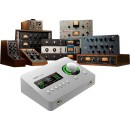
Universal Audio Apollo Solo Heritage Edition |
VS | |
|---|---|---|
| Analog: 2 Inputs / 4 Outputs at 192 kHz |
Channels of I/O |
Analog: 2 Inputs / 6 Outputs Digital: 2 Inputs / 2 Outputs |
| 192 kHz / 24-Bit | Maximum Sampling Rate | 192 kHz / 24-Bit |
| 2 Preamps | Number of Microphone Inputs | 2 Preamps |
| 2x Combo XLR-1/4" TRS Balanced Mic/Line Input 1x 1/4" TS Unbalanced Hi-Z Input (Front Panel) 2x 1/4" TRS Balanced Monitor Output 1x 1/4" TRS Unbalanced Headphone Output (Front Panel) |
Analog Audio I/O |
2x Combo XLR-1/4" TRS Balanced/Unbalanced Mic/Line/Hi-Z Input 2x 1/4" TRS Balanced Monitor Output (DC-Coupled) 1x Stereo RCA Coaxial Unbalanced Monitor Output 2x 1/4" TRS Unbalanced Headphone Output (Front Panel) |
| 1x USB-C | Host Connection | 1x USB-C (Class-Compliant) |
| macOS 10.14 macOS 10.15 macOS 11 macOS 12 Windows 10 (64-Bit Only) Windows 11 |
OS Compatibility |
macOS Windows |
| Thunderbolt Bus Power | Power Requirements | USB Bus Power |
